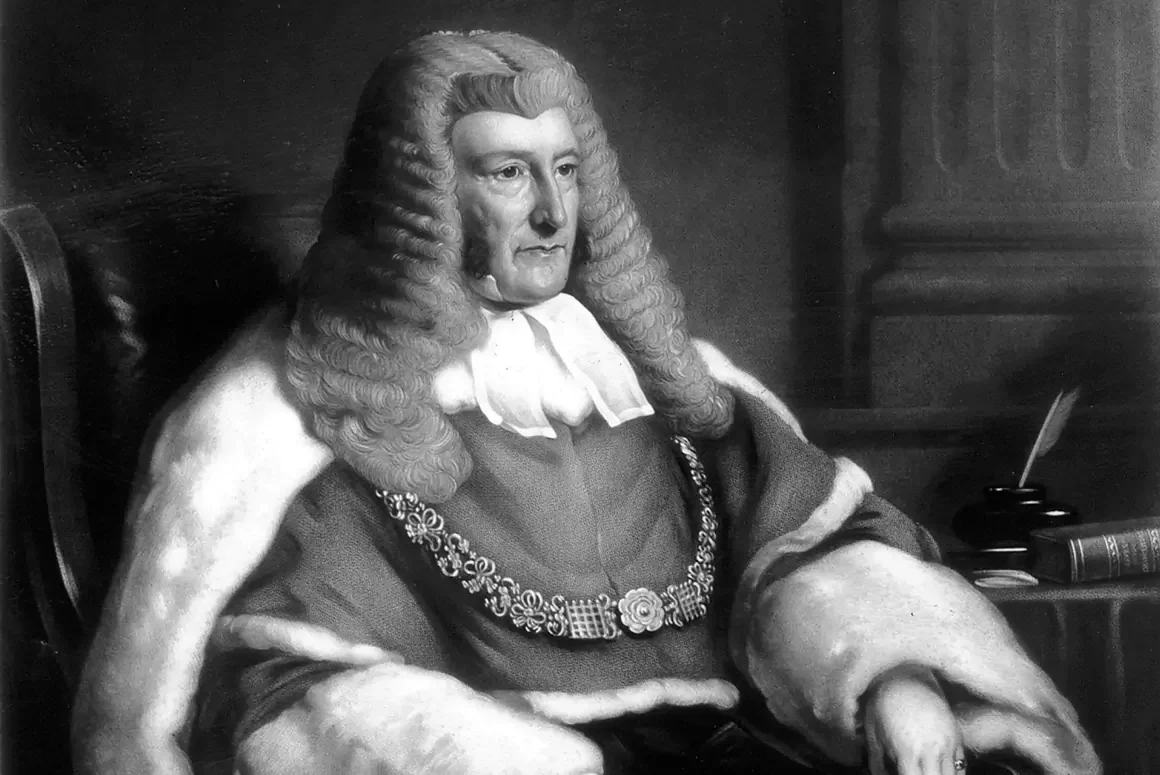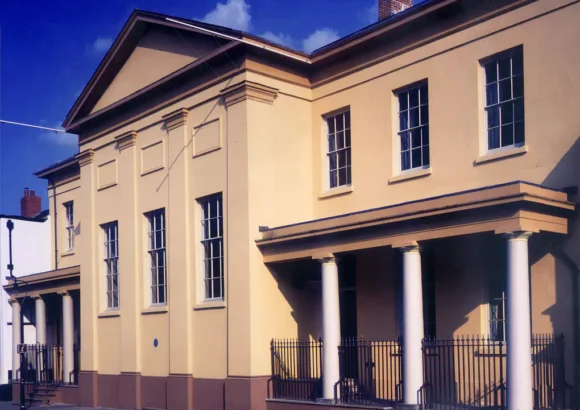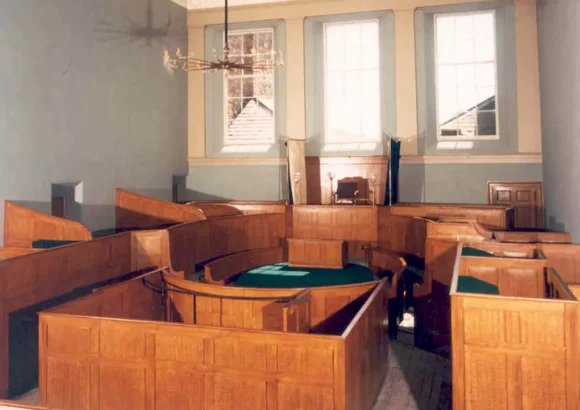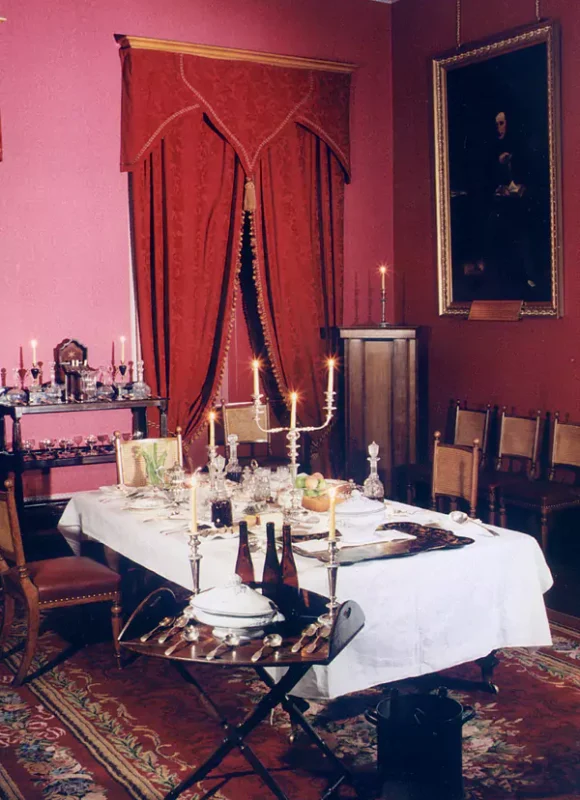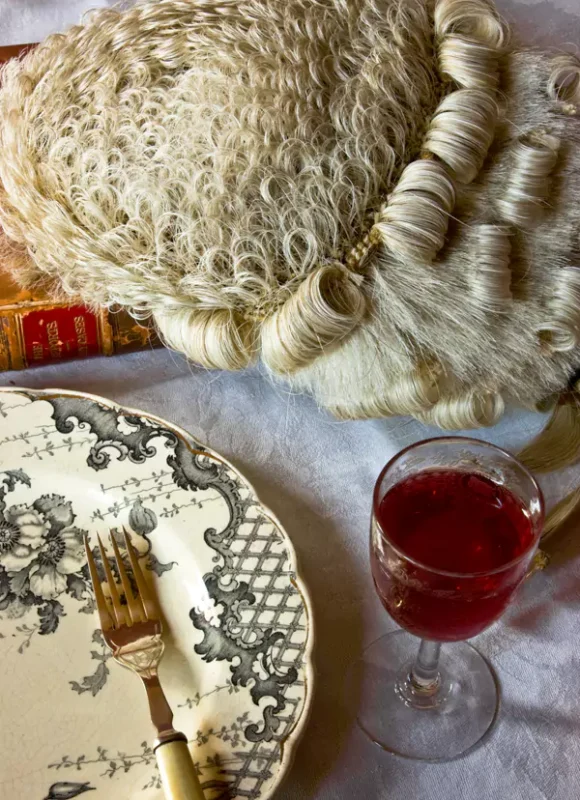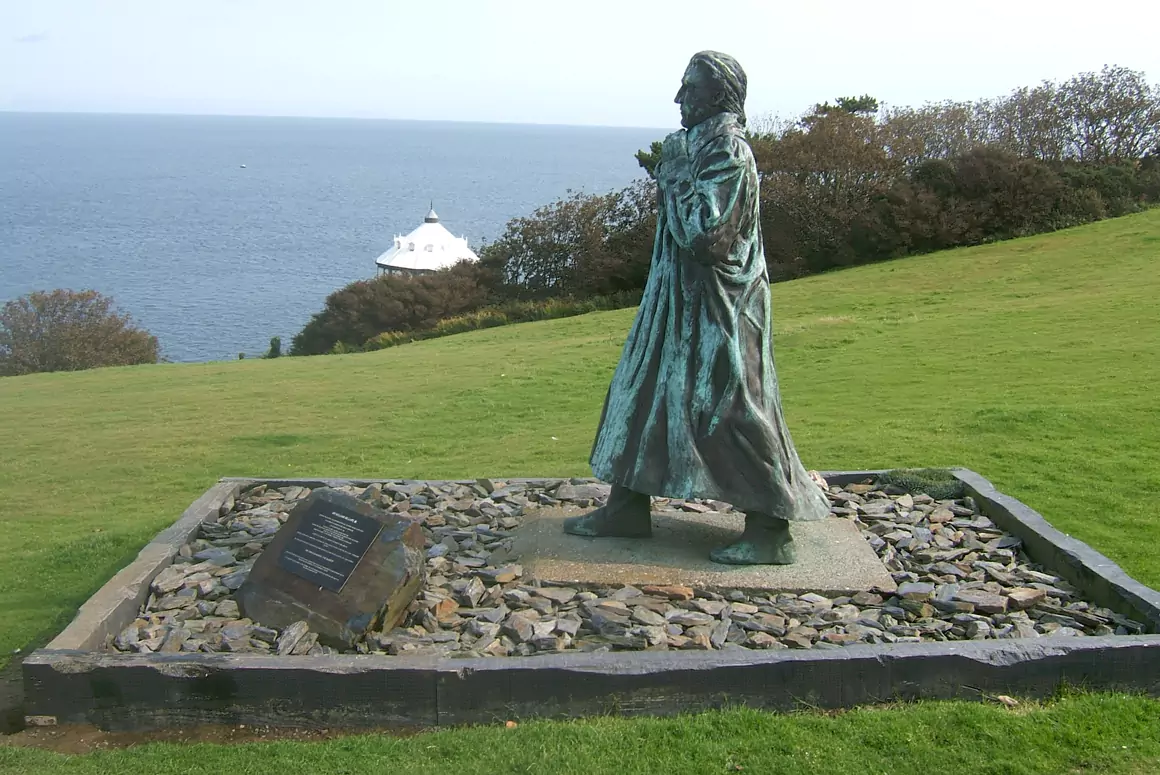It’s been called ‘truly inspirational’ by HRH Prince of Wales (Now King Charles III), ‘one of the world’s most appealing small museums’ by historian Dr John Davies and won numerous national awards, including ‘Britain’s Best Hidden Gem’. When the BBC brought Historic Royal Palaces Curator and historian, Lucy Worsley to film, she exclaimed ‘WHAT a stunning place!’ You really do need to see for yourself what all the fuss is over The Judge’s Lodging in the tiny border town of Presteigne. But why does such a quiet, picturesque town house have such an exceptional historic attraction? Well, it all started with a murder…..
The murder in Rhayader of one judge in the 1530s was to change the life of the tiny border town of Presteigne forever. Rhayader, chosen as the venue for the Court of King’s Great Sessions, was obviously not a safe enough place for eminent men to stay and in 1542 Presteigne was chosen as an alternative. Its life as the legal seat of Radnorshire was set for more than 400 years and with it the development of Presteigne into Radnorshire’s county town. There was a Shire Hall for the trials and hearings, a lodging house for the judges and a gaol.
By the 1820s, however, the old Shire Hall was on the brink of collapse, with it even needing contractors to prop it up when it was in heavy use. The judges had to be housed at the other end of the town from the court and the gaol was in such disrepair that it was hard for them to keep up with the number that escaped! Something had to be done. The gaol was demolished and a new one built on the edge of town so at least the villains were secure, but what about the judges?
- Courtroom from outside.
- Courtroom from the public gallery.
In 1826, the eminent Shrewsbury architect, Edward Haycock, won the contract for new grand Shire Hall, this time combining the courthouse itself with en-suite accommodation for the judges and office space for the county’s legal needs. Opening in 1829, this grand new building was to be the legal seat of Radnorshire for over 150 years. Many of the court cases were written up in the Hereford Times, including that of two Rhayader labourers who were arguing over the ownership of a pair of underpants which were apparently identified ‘due to their distinguishing marks’! The Radnorshire juries themselves won a reputation for a reluctance to convict, not surprising when they probably knew the people up before them. It is alleged that one judge, being driven to Knighton to catch his train, spotted a hare being hotly pursued by two greyhounds – ‘nothing but a Radnorshire jury can save that hare’ he cried. Whether or not the story is true, it does reflect the attitude towards the juries of the time! In 1834 a Quarter Sessions Jury was fined for tossing a coin to decided their verdict – the difficult decision being made impossible by one of them being the prisoner’s brother in law.
By the end of the 19th Century, however, increasing popularity of Llandrindod Wells meant that the newly formed County Council (1888 Local Government Act) chose the thriving spa resort as its future meeting place, sealing the fate of Presteigne’s county town status. Llandrindod did not, however, take the legal duties from Presteigne and it was not until October 1970 when Mr Justice Mars-Jones sat at the Autumn Assizes that the building said goodbye to the judges, with the magistrates continuing to deal with the lesser criminal matters for another 20 years.
As the use of the Shire Hall dwindled, its condition of repair worsened. By the early 1990s drastic action was needed if the building was to be saved from irreversible decay and, even worse, demolition. The interior was not too bad, despite rampant damp (and redecoration in rather garish 50s designs); some of the original furniture, though rather battered, was still in place and then there were the attics…..
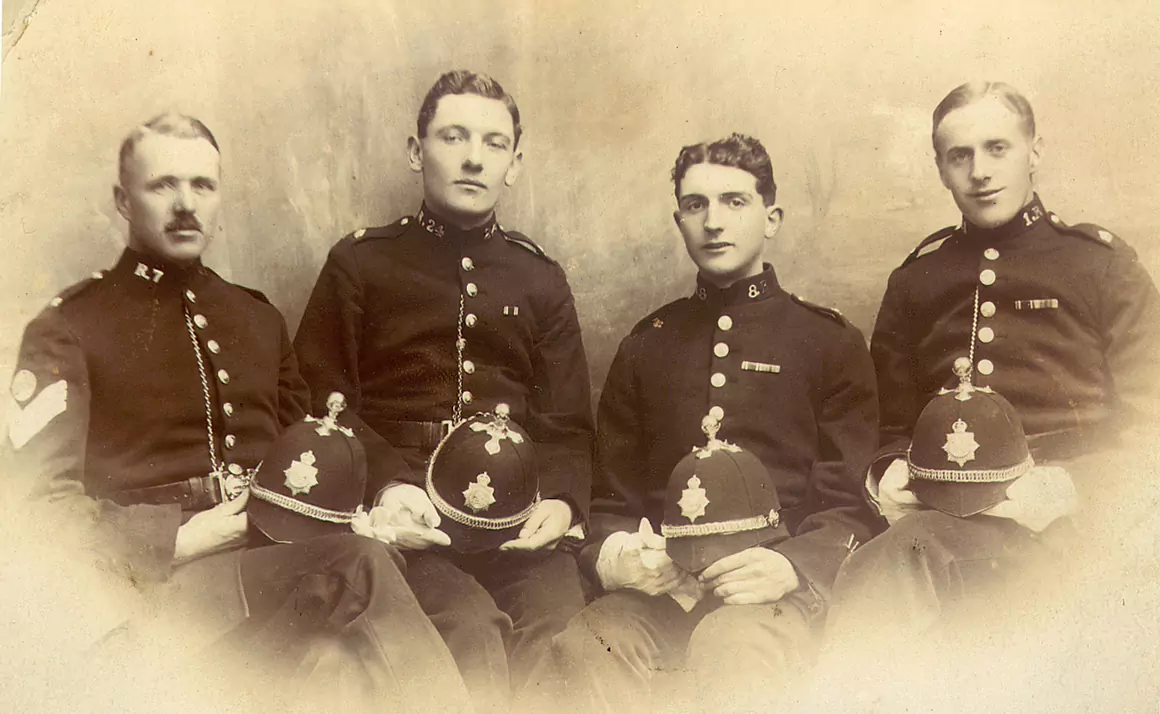
Never throw anything away – it might prove useful one day. Thank goodness the Shire Hall housekeepers of the 20th century had believed this! The attics were full of broken furniture, glassware, a whole trunk full of silverware, and portraits. The future of the building was set. It was decided that it should be transformed back to its mid Victorian heyday. A three year restoration programme saw electricity gradually removed and replaced with real fires, oil lamps, candles and gas. Today, The Judge’s Lodging operates as one of the only buildings in the UK to operate gas lighting on a daily basis. Furnishings in need of repair were removed to restorers, samples of paintwork from each room were used to match paint colours and wallpapers, whilst new carpets were woven and curtains hung. Antique shops were scoured to find small items lost over the years which would make it a functioning household. The rooms were then ready for their new life as a living museum.
‘The most commodious and elegant apartments for a judge in all England and Wales’.
Lord Chief Justice Campbell, 1855
The next task was to bring the house back to life. An audio tour was recorded in which the Victorian inhabitants of the building tell of their life – from Mary the hardworking maid, to Richard Lister Venables, Chairman of the Magistrates and employer of the famous Victorian diarist, Francis Kilvert. Local people were used for the servants voices, to provide real Radnorshire accents, with Mr Venables being played by the distinguished voice of actor Robert Hardy. With all complete on 24th May 1997, Robert Hardy stepped out of his horse-drawn 1860s carriage, cut the ribbon and declared the building open. Although The Judge’s Lodging’s life has started anew, judges do still visit, but this time it is to share a bit of their profession’s history with family and friends!
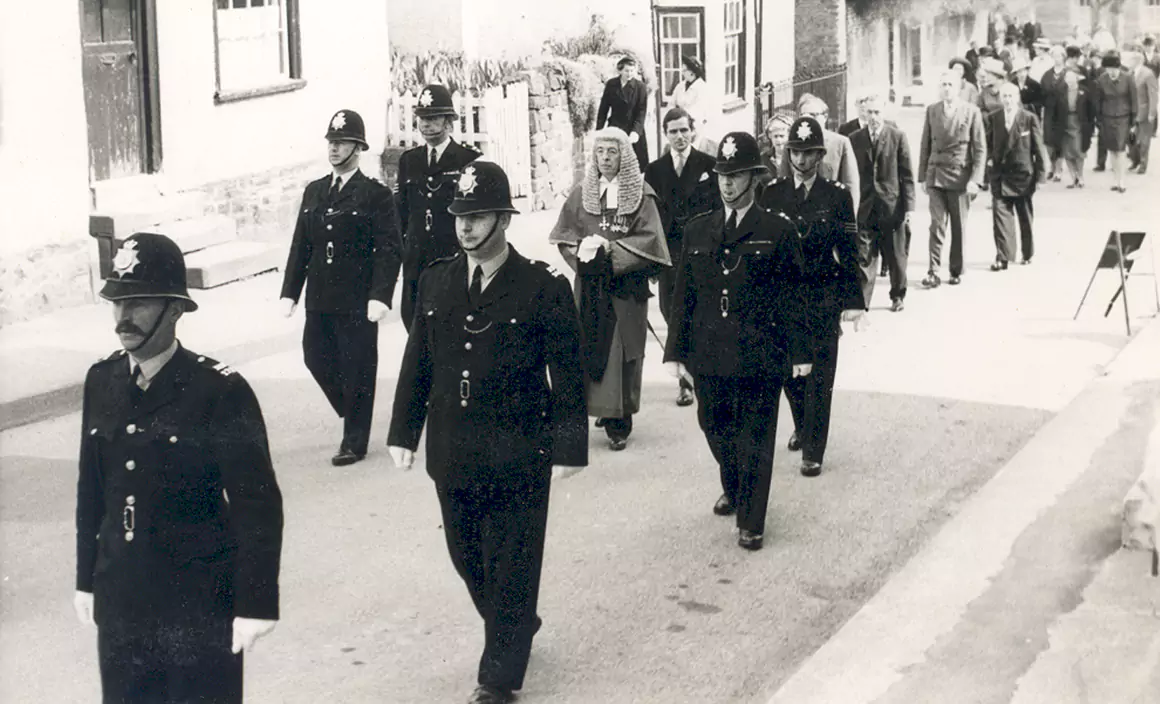
In 2017, this historic building celebrates 20 years since it opened its doors as a museum. Visitors can now explore the ‘upstairs downstairs’ lives of its Victorian inhabitants, from Judge’s to their servants and felonious guests, all by the flicker of gas and oil lighting throughout and a total hands-on policy that allows you to immerse yourself into their world. As you walk through the Judge’s door into his apartments, the smell of the lamps and the ashes of the fires mingle to instantly transport you back in time. Wander through the judge’s private apartments and make yourself at home – you can lie on the beds, read the judge’s books and even pump water in the kitchen. Below stairs there is the full range of servants’ rooms to explore, with kitchens, sleeping quarters and workrooms. The tour is finished by a trip to the grim cells and vast echoing courtroom, where you are haunted by the echoes of trials long since concluded.
There are plenty of events throughout the year to add to your enjoyment, plus temporary exhibitions, talks, activity trails, school holiday activities and more. If you have children to entertain, you don’t have to worry about being told off every time they move, because the building is family-friendly. They even have their own guidebook entitled ‘Interesting Stuff, Gross Facts and a bit About the Building’.
- The Dining Room
- Wig on Dining Table
The Judge’s Lodging has long had a reputation for liking the quirkier side of history, so a visit to the museum will treat all ages to all sorts of fascinating insights into Victorian living, from jelly-making and napkin folding to toilet habits and household maintenance hints. If you have a group looking for a really different visit, there are all sorts of pre-bookable tours available, including even an ‘Ice-Cream & Jelly for Grown Ups’ session, and for those looking for a truly memorable wedding, you can even get married in the dock! It really is a true revelation.
For full opening times and prices, (or just to discover strange Victorian facts!) look at their website: www.judgeslodging.org.uk
Address: The Judge’s Lodging, Broad Street, Presteigne, Powys LD8 2AD
Tel: 01544 260650
Email: info@judgeslodging.org.uk
Words: Gabrielle Rivers
Pictures: The Judge’s Lodgings & Exterior photo by Alex Ramsay
Feature image: Lord Chief Justice Campbell, 1855
First published in Welsh Country Magazine Sept – Oct 2017


